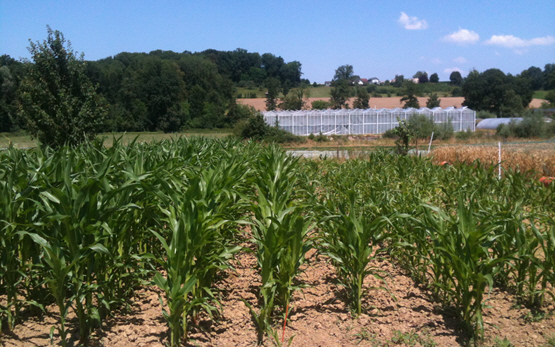The DOK trial was set up as a comparative study of conventional and organic agriculture. The aim was to determine whether organic farming is able to perform in the long term and keep pace with conventional agriculture in terms of yields and yield quality. Today, the trial serves as an experimental platform for many other research objectives, with a particular focus on yield performance and stability, sustainable agriculture, soil quality, climate impact, energy and nutrient efficiency, and biodiversity.

Trial Design
The DOK trial was launched in 1978 in Therwil (canton of Basel-Country) on a pseudogleyic Luvisol. The trial compares three farming systems: biodynamic (D), bioorganic (O) and conventional (K; German: konventionell) agriculture. These systems differ both in terms of fertilisation (D: slurry, manure compost, biodynamic preparations; O: slurry, rotted manure; K: slurry, fresh or rotted manure, mineral fertilisers) and plant-protection (D and O: biological; K: chemical-synthetic). In addition to two fertilisation levels of the three farming systems (half and full fertilisation, respectively), two controls are implemented, viz., an unfertilised (N) and a purely mineral-fertilised treatment (M). The trial comprises four field replications. In addition, the seven-year crop rotation, consisting of two years of temporary ley – silage maize – soybean – winter wheat – potatoes – winter wheat, is repeated in three strips that are shifted by one year in each case.
Measurements
The topsoil (0–0.2 m depth) is sampled annually and the subsoil (0.3–0.5 m) every seven years. Routine measurements include soil pH, organic carbon and nitrogen, and available macronutrients. Soil physical and biological measurements are also conducted at regular intervals. Yields of main and by-products are recorded on a regular basis, and nutrient content as well as quality parameters are determined analytically. The DOK trial also serves as a scientific platform for many fundamental and applied research objectives, such as biological nitrogen fixation, below-ground carbon and nitrogen input by crops, or greenhouse-gas emissions. The numerous parameters recorded are used in life-cycle assessments and models of soil carbon and nitrogen balances (Roth-C, Humod, CCB) or nitrogen dynamics in the plant-soil system (Sticks, DayCent), thereby enabling an improved understanding of the system. The DOK trial is thus one of the most renowned long-term trials worldwide.
Contact
Key data
Topic: Farming systems, fertilisation intensity
Site: Therwil (BL)
Location: 47.502582, 7.539340;
306 m a.s.l.
Start year: 1978
Design: strip-split-plot, 3 x 4 replications
Soil type (WRB): pseudogleyic Luvisol
Soil texture: Silt (15% clay, 70% silt, 15% sand, 1.2% org. C)
Precipitation: 840 mm
Temperature: 10.5 °C
Project partners
Further Information
Last modification 17.10.2025















